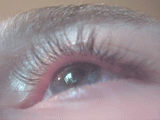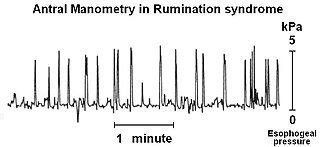Neuromyotonia (NMT) is a form of peripheral nerve hyperexcitability that causes spontaneous muscular activity resulting from repetitive motor unit action potentials of peripheral origin. NMT along with Morvan's syndrome are the most severe types in the Peripheral Nerve Hyperexciteability spectrum. Example of two more common and less severe syndromes in the spectrum are cramp fasciculation syndrome and benign fasciculation syndrome. NMT can have both hereditary and acquired (non-inherited) forms. The prevalence of NMT is unknown.
Factitious disorder imposed on self, also known as Munchausen syndrome, is a factitious disorder in which those affected feign or induce disease, illness, injury, abuse, or psychological trauma to draw attention, sympathy, or reassurance to themselves. Munchausen syndrome fits within the subclass of factitious disorder with predominantly physical signs and symptoms, but patients also have a history of recurrent hospitalization, travelling, and dramatic, extremely improbable tales of their past experiences. The term Munchausen syndrome derives its name from the fictional character Baron Munchausen.

Ehlers–Danlos syndromes (EDS) are a group of 13 genetic connective-tissue disorders. Symptoms often include loose joints, joint pain, stretchy velvety skin, and abnormal scar formation. These may be noticed at birth or in early childhood. Complications may include aortic dissection, joint dislocations, scoliosis, chronic pain, or early osteoarthritis. The current classification was last updated in 2017, when a number of rarer forms of EDS were added.

Benign fasciculation syndrome (BFS) is characterized by fasciculation (twitching) of voluntary muscles in the body. The twitching can occur in any voluntary muscle group but is most common in the eyelids, arms, hands, fingers, legs, and feet. The tongue can also be affected. The twitching may be occasional to continuous. BFS must be distinguished from other conditions that include muscle twitches.

Alice in Wonderland syndrome (AIWS), also known as Todd's syndrome or dysmetropsia, is a neurological disorder that distorts perception. People with this syndrome may experience distortions in their visual perception of objects, such as appearing smaller (micropsia) or larger (macropsia), or appearing to be closer (pelopsia) or farther (teleopsia) than they are. Distortion may also occur for senses other than vision.
In medicine, comorbidity refers to the simultaneous presence of two or more medical conditions in a patient; often co-occurring with a primary condition. It originates from the Latin term morbus prefixed with co- ("together") and suffixed with -ity. Comorbidity includes all additional ailments a patient may experience alongside their primary diagnosis, which can be either physiological or psychological in nature. In the context of mental health, comorbidity frequently refers to the concurrent existence of mental disorders, for example, the co-occurrence of depressive and anxiety disorders. The concept of multimorbidity is related to comorbidity but is different in its definition and approach, focusing on the presence of multiple diseases or conditions in a patient without the need to specify one as primary.
Tension myositis syndrome (TMS), also known as tension myoneural syndrome or mindbody syndrome, is a name given by John E. Sarno to what he claimed was a condition of psychogenic musculoskeletal and nerve symptoms, most notably back pain. Sarno described TMS in four books, and stated that the condition may be involved in other pain disorders as well. The treatment protocol for TMS includes education, writing about emotional issues, resumption of a normal lifestyle and, for some patients, support meetings and/or psychotherapy.

Raynaud syndrome, also known as Raynaud's phenomenon, is a medical condition in which the spasm of small arteries causes episodes of reduced blood flow to end arterioles. Typically the fingers, and, less commonly, the toes, are involved. Rarely, the nose, ears, nipples, or lips are affected. The episodes classically result in the affected part turning white and then blue. Often, numbness or pain occurs. As blood flow returns, the area turns red and burns. The episodes typically last minutes but can last several hours. The condition is named after the physician Auguste Gabriel Maurice Raynaud, who first described it in his doctoral thesis in 1862.

Rumination syndrome, or merycism, is a chronic motility disorder characterized by effortless regurgitation of most meals following consumption, due to the involuntary contraction of the muscles around the abdomen. There is no retching, nausea, heartburn, odour, or abdominal pain associated with the regurgitation as there is with typical vomiting, and the regurgitated food is undigested. The disorder has been historically documented as affecting only infants, young children, and people with cognitive disabilities . It is increasingly being diagnosed in a greater number of otherwise healthy adolescents and adults, though there is a lack of awareness of the condition by doctors, patients, and the general public.

MERRF syndrome is a mitochondrial disease. It is extremely rare, and has varying degrees of expressivity owing to heteroplasmy. MERRF syndrome affects different parts of the body, particularly the muscles and nervous system. The signs and symptoms of this disorder appear at an early age, generally childhood or adolescence. The causes of MERRF syndrome are difficult to determine, but because it is a mitochondrial disorder, it can be caused by the mutation of nuclear DNA or mitochondrial DNA. The classification of this disease varies from patient to patient, since many individuals do not fall into one specific disease category. The primary features displayed on a person with MERRF include myoclonus, seizures, cerebellar ataxia, myopathy, and ragged red fibers (RRF) on muscle biopsy, leading to the disease's name. Secondary features include dementia, optic atrophy, bilateral deafness, peripheral neuropathy, spasticity, or multiple lipomata. Mitochondrial disorders, including MERRFS, may present at any age.
Self-diagnosis is the process of diagnosing, or identifying, medical conditions in oneself. It may be assisted by medical dictionaries, books, resources on the Internet, past personal experiences, or recognizing symptoms or medical signs of a condition that a family member previously had or currently has.
A wastebasket diagnosis or trashcan diagnosis is a vague diagnosis given to a patient or to medical records department for essentially non-medical reasons. It may be given when the patient has an obvious but unidentifiable medical problem, when a doctor wants to reassure an anxious patient about the doctor's belief in the existence of reported symptoms, when a patient pressures a doctor for a label, or when a doctor wants to facilitate bureaucratic approval of treatment. It differs from a diagnosis of exclusion in that a wastebasket diagnosis is a diagnostic label of doubtful value, whereas a diagnosis of exclusion is characterized by the diagnosis being arrived at indirectly. Unlike a vague wastebasket diagnosis, the diagnostic label arrived at through a process of exclusion may be precise, accurate, and helpful.

Superior mesenteric artery (SMA) syndrome is a gastro-vascular disorder in which the third and final portion of the duodenum is compressed between the abdominal aorta (AA) and the overlying superior mesenteric artery. This rare, potentially life-threatening syndrome is typically caused by an angle of 6–25° between the AA and the SMA, in comparison to the normal range of 38–56°, due to a lack of retroperitoneal and visceral fat. In addition, the aortomesenteric distance is 2–8 millimeters, as opposed to the typical 10–20. However, a narrow SMA angle alone is not enough to make a diagnosis, because patients with a low BMI, most notably children, have been known to have a narrow SMA angle with no symptoms of SMA syndrome.

Medical diagnosis is the process of determining which disease or condition explains a person's symptoms and signs. It is most often referred to as a diagnosis with the medical context being implicit. The information required for a diagnosis is typically collected from a history and physical examination of the person seeking medical care. Often, one or more diagnostic procedures, such as medical tests, are also done during the process. Sometimes the posthumous diagnosis is considered a kind of medical diagnosis.
Morgellons is the informal name of a self-diagnosed, scientifically unsubstantiated skin condition in which individuals have sores that they believe contain fibrous material. Morgellons is not well understood, but the general medical consensus is that it is a form of delusional parasitosis, on the psychiatric spectrum. The sores are typically the result of compulsive scratching, and the fibers, when analysed, are consistently found to have originated from cotton and other textiles.
Folie à deux, also known as shared psychosis or shared delusional disorder (SDD), is a rare psychiatric syndrome in which symptoms of a delusional belief, are "transmitted" from one individual to another.
PHACE syndrome is a medical condition involving the uncommon association between large infantile hemangiomas, usually of the face, and birth defects of the brain, heart, eyes, skin and/or arteries. PHACE is an acronym that stands for the medical names of the parts of the body it often impacts:
Chronic Lyme disease (CLD) is the name used by some people with non-specific symptoms, such as fatigue, muscle pain, and cognitive dysfunction to refer to their condition, even if there is no evidence that they had Lyme disease. Both the label and the belief that these people's symptoms are caused by this particular infection are generally rejected by medical professionals. Chronic Lyme disease is distinct from post-treatment Lyme disease syndrome, a set of lingering symptoms which may persist after successful antibiotic treatment of infection with Lyme-causing Borrelia bacteria, and which may have similar symptoms to those associated with CLD.
Diagnosis is a 2019 documentary television series. The series follows Dr. Lisa Sanders as she attempts to help patients with rare illnesses and searches for a diagnosis and cure using wisdom of the crowd methods. The show is based on her column for The New York Times Magazine. It was released on August 16, 2019, on Netflix.
A neurological syndrome of unknown cause was identified as a potential novel degenerative disease in a cluster of individuals with similar clinical signs and symptoms in the Canadian province of New Brunswick beginning in 2019. Symptoms listed on the New Brunswick Public Health (NBPH) website include memory problems, muscle spasms, balance problems, difficulty walking or falls, blurred vision or visual hallucinations, unexplained or significant weight loss, behaviour changes, and pain in the upper or lower limbs.







